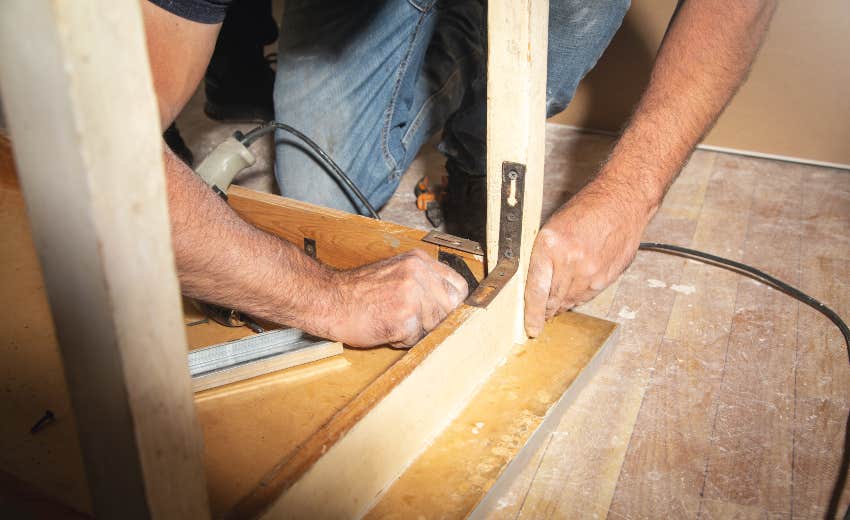The Home Improvement Project That Nearly Ended Our 15-Year Marriage — 'It Became A Battleground'
How we survived the ultimate test of my relationship.
 Meeko Media | Canva
Meeko Media | Canva My husband and I are remodeling an older home, and so far we’re still talking. It’s not the first time we’ve taken on this type of project.
About 15 years ago, we renovated a handful of tired, weary houses into beautiful welcoming homes for new families to enjoy.
My husband’s background in construction and my knack for creating and designing interior spaces seemed like a good match — one that would allow us to spend more time together and strengthen our bond.
So we jumped in with both feet, a positive attitude, and crossed fingers. While we had a reasonable degree of construction knowledge — and were willing and able to do most of the work ourselves — there were a lot of unknowns.
For example, we had no idea what problems and secrets lay hidden behind the wallpaper, in the plumbing and electrical systems, or attics, roofs, and foundations. Code violations from previous unpermitted work were an ongoing and frustrating challenge. Delays caused by material shortages — along with escalating budgets — brought high levels of stress and anxiety to the forefront.
 ANDRANIK HAKOBYAN / Shutterstock
ANDRANIK HAKOBYAN / Shutterstock
Despite our good intentions, the reality of facing the daily decisions necessary to breathe new life into the renovation became a battleground — and an arena for airing our grievances.
Because, like the houses we were working on, our relationship was badly in need of maintenance, updating, and improvement. While we approached each remodel design strategy with a common mindset, the minutiae in details, style choices, standard and custom options, and budgetary considerations often raised their ugly, insistent heads.
Small congenial discussions led to lengthy, often stressful disagreements. Unilateral decisions made at the moment came back to bite one of us, leaving the other irritated and disappointed. And occasionally, our alleged mutual goals hit a literal wall, causing delays and ego-laden tactics to come into play.
We soon discovered that we hadn’t taken into account how the underlying pitfalls from the constant demands of the project would impact — and strain — our relationship. As the work progressed and things became more tenuous, I wondered if our increased bickering and squabbling had been a subconscious attempt on both our parts to subversively suggest there was a need for a few changes in each other.
The result? Our relationship began to suffer, with no obvious solution for repair. I must admit, those were rocky years for our marriage. (Research says the toughest year of marriage is often year 7, says a study from Divorce Online.) By losing sight of our ultimate aim — transforming and improving the appeal of a home — we had translated our perspective and opinions of paint colors, cabinets, and flooring into a personal affront.
Without realizing the potential consequences, we allowed the problems we were facing in the house project to affect our feelings about each other.
For the most part, it worked out. Having committed upfront to see each project through was a promise we had made to each other — despite the ugly scenes and vocal confrontations. In hindsight, we eventually realized the process may have been a bit easier on our marriage if we’d been more realistic about the possible side effects. But the seeds of discontent had been planted.
Fast forward 15 years. Recently, another opportunity to renovate a home crossed our path. And we said yes. I know what you’re thinking. Why would we even consider a repeat performance — and test — of our marriage? Why didn’t we politely decline and retreat, perhaps deciding to plan a romantic weekend instead to take us away from the worries of life and reconnect with each other? Good question.
Many of us are guided by a process in our brains that controls our memories with a guarded agenda meant to serve and protect. This personally installed trigger releases a self-defense mechanism that shifts the unpleasant and uncomfortable experiences aside, tucking those nasty reality bites into a dusty corner.
This instinctual protective shield intentionally filters the complete, true story of our past actions and decisions, allowing only the positive outcomes to remain readily accessible while keeping any tainted aspects of our behavior — and their results — out of mental reach.
A friend of mine once expressed a similar version of this concept after learning she was pregnant with her second child. Having made the decision not to have children, I found her story both interesting and insightful. Her heartfelt disclosure felt strangely familiar and, as it turned out, personally relevant.
Thrilled about the upcoming birth of her son, my friend recalled the memories of seeing her daughter’s face for the first time, their instant bond and connection of love, and cradling her baby in her arms as the child slept in angelic peace. She held these joyful thoughts dear, anticipating the arrival of the newest addition to her family.
After her son was born and they were settled back home, she confided how she’d forgotten many aspects of her first pregnancy — the discomfort and weight gain, the lack of confidence and agility, the fear and uncertainty about her baby’s health. And mostly, the hours of agonizing labor and postpartum depression — until reality showed up and released those memories once again. (Postpartum depression (PPD) affects between 10% and 15% of adult mothers each year, according to statistics.)
Last week, after stepping inside the new project home, I understood exactly what she meant. While the warm, fuzzy recollections from years ago had convinced us to relive the experience, we once again found ourselves in the middle of a literal and personal mess. And all those previously dormant flashbacks began filling my brain with red flags and flashing lights — insistent reminders of what lay ahead. Both the needy house and our relationship were about to transform. I’m keeping a positive mindset.
Because the next home renovation my husband and I do together, I like to think we’re better prepared to handle the unavoidable hurdles objectively and positively.
And to make sure we keep our marriage on track — despite the likely disagreements about design selections, shades of paint, or any of the hundred other aspects we’ll encounter — we’ve decided to let the choices be determined by flipping a coin. No heated discussions or debates are allowed. And all decisions are final and sealed with a pinky swear not to point fingers or place blame — regardless of our stubborn egos.
Jill Reid is the author of the Real Life Book Series and founder of Pathway to Personal Growth.

